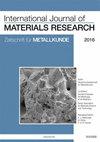楝树籽和花生壳生物填料对黄麻纤维增强环氧树脂复合材料机械性能、吸水性和热性能的混合效应
IF 0.7
4区 材料科学
Q4 METALLURGY & METALLURGICAL ENGINEERING
引用次数: 0
摘要
摘要 天然复合材料具有重量轻、无害、便宜和易于加工等优点。然而,与传统材料相比,它们的性能有限。因此,需要提高天然复合材料的性能,以扩大其在各种工业应用中的使用范围。本研究尝试使用楝树籽和花生壳颗粒制成的不同天然填料来提高环氧黄麻天然复合材料的性能。首先,制备了环氧黄麻复合材料 [N:G (0:0)],并对复合材料的性能进行了研究。此外,还在 N:G (0:0) 复合材料中加入了天然填料,并制成了多种复合材料。其中包括 N:G (1:0)、N:G (3:1)、N:G (1:1)、N:G (1:3) 和 N:G (0:1),楝树和落花生壳颗粒的重量分数作了相应调整。将上述复合材料的性能与 N:G (0:0) 复合材料的性能进行了比较。结果显示,颗粒增强复合材料的性能有了显著改善。此外,与其他复合材料相比,N:G(0:1)复合材料的抗拉强度(43.28 兆帕)、抗弯强度(46.08 兆帕)、抗冲击性(13.93 kJ m-2)和硬度(24.7 HV)都更胜一筹。这可能是由于落花生壳具有纤维结构,而楝树种子的性质比较脆弱。此外,同一种复合材料的吸水率较低(6 天时为 2.8%)。此外,N:G(1:0)复合材料的导热系数最小(0.31 W m-1 K-1)。根据这些结果,可以得出结论:楝树籽和落花生壳颗粒等生物填料有助于改善环氧黄麻复合材料的性能。本文章由计算机程序翻译,如有差异,请以英文原文为准。
Hybrid effect of neem seed and groundnut shell bio-fillers on the mechanical, water absorption and thermal properties of jute fiber reinforced epoxy composites
Abstract Natural composites possess good qualities like light weight, harmlessness, cheapness and ease of processing. However, their performance is limited compared to conventional material. Hence, it is required to improve the performance of natural composites to extend their usage in various industrial applications. In this research, an attempt has been made to improve the performance of epoxy–jute natural composite using different natural fillers made of neem seed and groundnut shell particles. Initially, the epoxy–jute composite [N:G (0:0)] was prepared and the properties of the composite were investigated. Additionally, natural-fillers were incorporated into the N:G (0:0) composite, and a variety of composites were produced. These included N:G (1:0), N:G (3:1), N:G (1:1), N:G (1:3), and N:G (0:1), with the weight fractions of neem and groundnut shell particles adjusted accordingly. The properties of the aforementioned composites were compared with the properties of N:G (0:0) composite. Results revealed that the particle reinforced composite exhibited significant improvement in the properties of the composites. Moreover, in comparison to the other composites, the N:G (0:1) composite exhibited superior tensile strength (43.28 MPa), flexural strength (46.08 MPa), impact resistance (13.93 kJ m−2), and hardness (24.7 HV). This could be due to the fibrous structure of groundnut shell compared to neem seed which was fragile in nature. Furthermore, the same composite displayed less water absorption (2.8 % at 6 days time period). Moreover, the N:G (1:0) composite exhibited the least thermal conductivity (0.31 W m−1 K−1). Based on results, it was concluded that the bio-fillers such as neem seed and groundnut shell particles assisted improvement the properties of epoxy–jute composite.
求助全文
通过发布文献求助,成功后即可免费获取论文全文。
去求助
来源期刊
CiteScore
1.30
自引率
12.50%
发文量
119
审稿时长
6.4 months
期刊介绍:
The International Journal of Materials Research (IJMR) publishes original high quality experimental and theoretical papers and reviews on basic and applied research in the field of materials science and engineering, with focus on synthesis, processing, constitution, and properties of all classes of materials. Particular emphasis is placed on microstructural design, phase relations, computational thermodynamics, and kinetics at the nano to macro scale. Contributions may also focus on progress in advanced characterization techniques. All articles are subject to thorough, independent peer review.

 求助内容:
求助内容: 应助结果提醒方式:
应助结果提醒方式:


